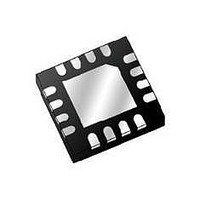MMA6233QR2 Freescale Semiconductor, MMA6233QR2 Datasheet - Page 4

MMA6233QR2
Manufacturer Part Number
MMA6233QR2
Description
SENSOR ACCEL X/Y-AXIS 10G 16-QFN
Manufacturer
Freescale Semiconductor
Series
MMA6200r
Datasheet
1.KIT1925MMA6231Q.pdf
(11 pages)
Specifications of MMA6233QR2
Axis
X, Y
Acceleration Range
±10g
Sensitivity
120mV/g
Voltage - Supply
2.7 V ~ 3.6 V
Output Type
Analog
Bandwidth
900Hz
Mounting Type
Surface Mount
Package / Case
16-QFN Exposed Pad
Sensing Axis
X, Y
Acceleration
10 g
Maximum Operating Temperature
+ 85 C
Minimum Operating Temperature
- 20 C
Interface
-
Lead Free Status / Rohs Status
Lead free / RoHS Compliant
MMA6231Q
4
integrated-circuit accelerometer.
capacitive sensing cell (g-cell) and a signal conditioning ASIC
contained in a single integrated circuit package. The sensing
element is sealed hermetically at the wafer level using a bulk
micromachined cap wafer.
semiconductor materials (polysilicon) using semiconductor
processes (masking and etching). It can be modeled as a set
of beams attached to a movable central mass that moves
between fixed beams. The movable beams can be deflected
from their rest position by subjecting the system to an
acceleration
distance from them to the fixed beams on one side will
increase by the same amount that the distance to the fixed
beams on the other side decreases. The change in distance
is a measure of acceleration.
(Figure
distance between the plates changes and each capacitor's
value will change, (C = Aε/D). Where A is the area of the
plate, ε is the dielectric constant, and D is the distance
between the plates.
the g-cell capacitors and extract the acceleration data from
the difference between the two capacitors. The ASIC also
signal conditions and filters (switched capacitor) the signal,
providing a high level output voltage that is ratiometric and
proportional to acceleration.
The Freescale accelerometer is a surface-micromachined
The device consists of a surface micromachined
The g-cell is a mechanical structure formed from
As the beams attached to the central mass move, the
The g-cell plates form two back-to-back capacitors
The ASIC uses switched capacitor techniques to measure
Figure 3. Transducer
Physical Model
4). As the center plate moves with acceleration, the
(Figure
Acceleration
3).
Figure 4. Equivalent
Circuit Model
PRINCIPLE OF OPERATION
Filtering
single-pole switched capacitor filter. Because the filter is
realized using switched capacitor techniques, there is no
requirement for external passive components (resistors and
capacitors) to set the cut-off frequency.
Self-Test
verification of the mechanical and electrical integrity of the
accelerometer at any time before or after installation. A fourth
plate is used in the g-cell as a self-test plate. When a logic
high input to the self-test pin is applied, a calibrated potential
is applied across the self-test plate and the moveable plate.
The resulting electrostatic force (Fe =
center plate to deflect. The resultant deflection is measured
by the accelerometer's ASIC and a proportional output
voltage results. This procedure assures both the mechanical
(g-cell) and electronic sections of the accelerometer are
functioning.
and a fault latch. Parity of the EEPROM bits becomes odd in
number.
Ratiometricity
sensitivity will scale linearly with applied supply voltage. That
is, as supply voltage is increased, the sensitivity and offset
increase linearly; as supply voltage decreases, offset and
sensitivity decrease linearly. This is a key feature when
interfacing to a microcontroller or an A/D converter because
it provides system level cancellation of supply induced errors
in the analog to digital conversion process.
These Freescale accelerometers contain an onboard
The sensor provides a self-test feature allowing the
Freescale accelerometers include fault detection circuitry
Self-test is disabled when EEPROM parity error occurs.
Ratiometricity simply means the output offset voltage and
SPECIAL FEATURES
Freescale Semiconductor
1
/
2
AV
2
/d
2
) causes the
Sensors










